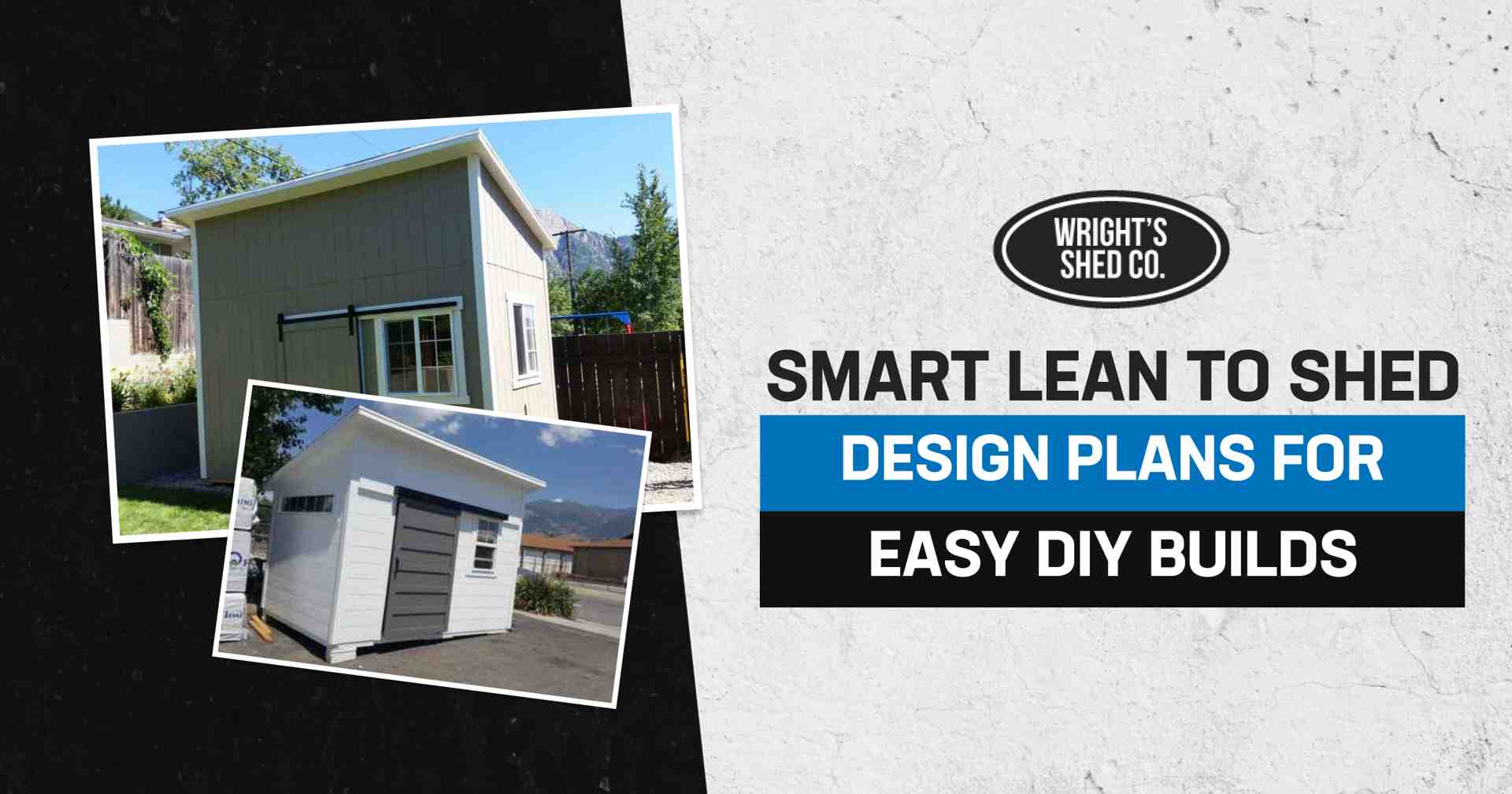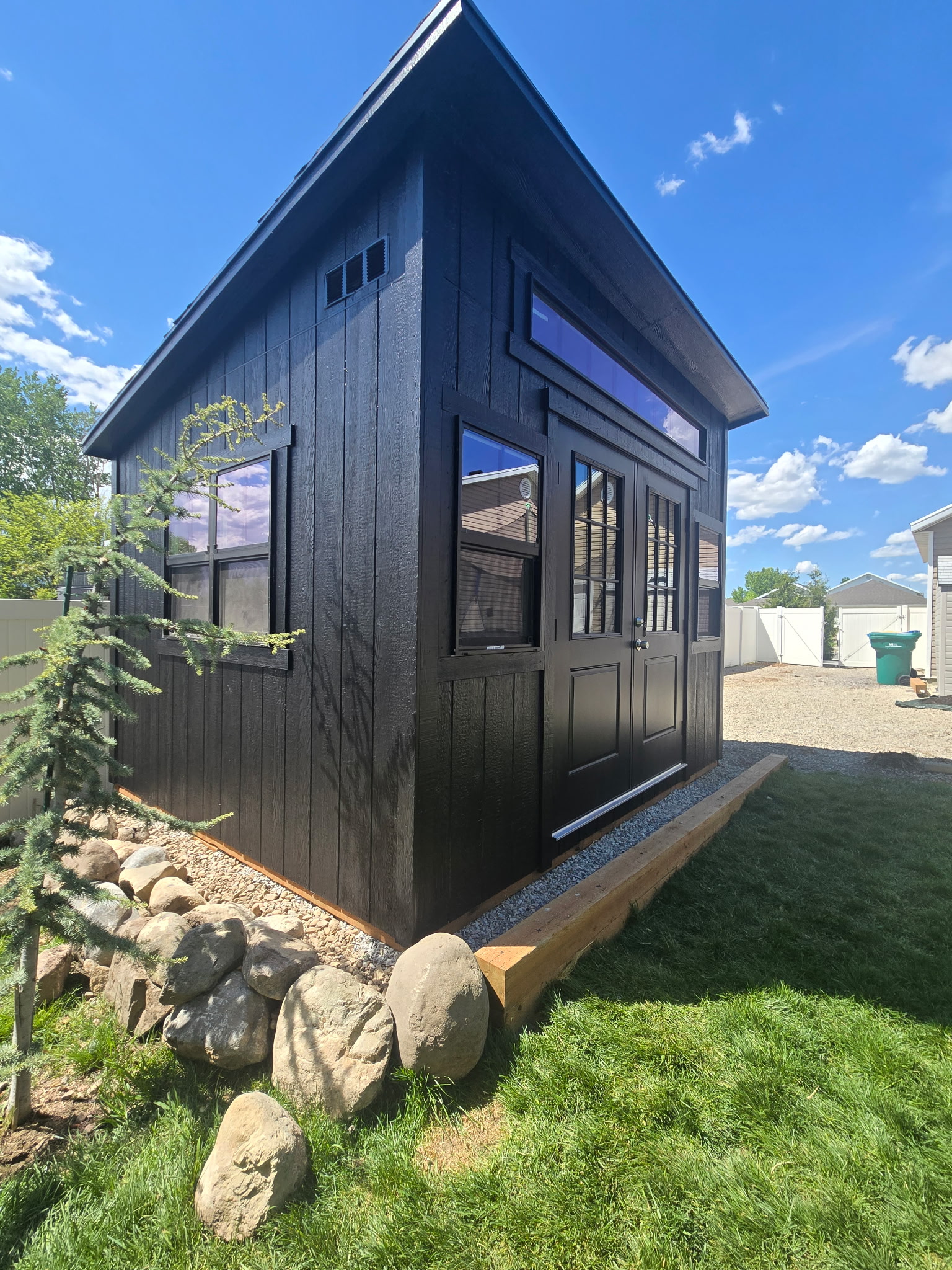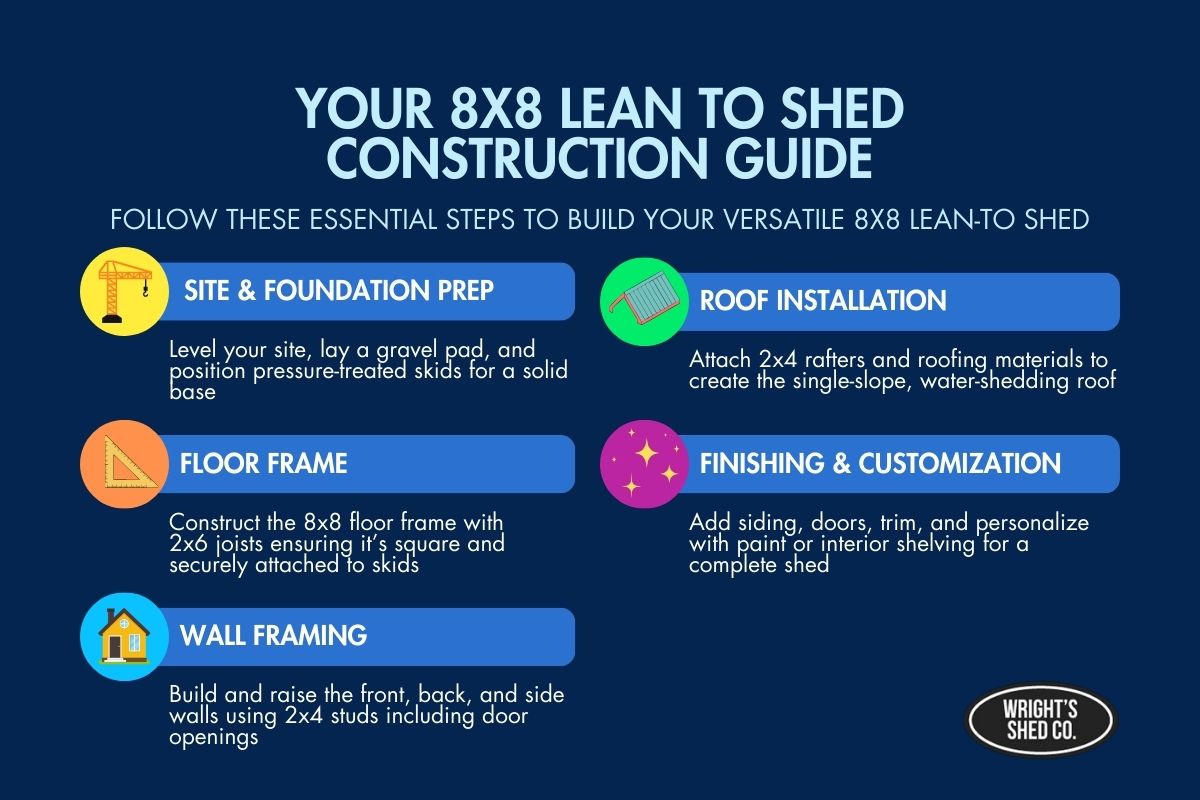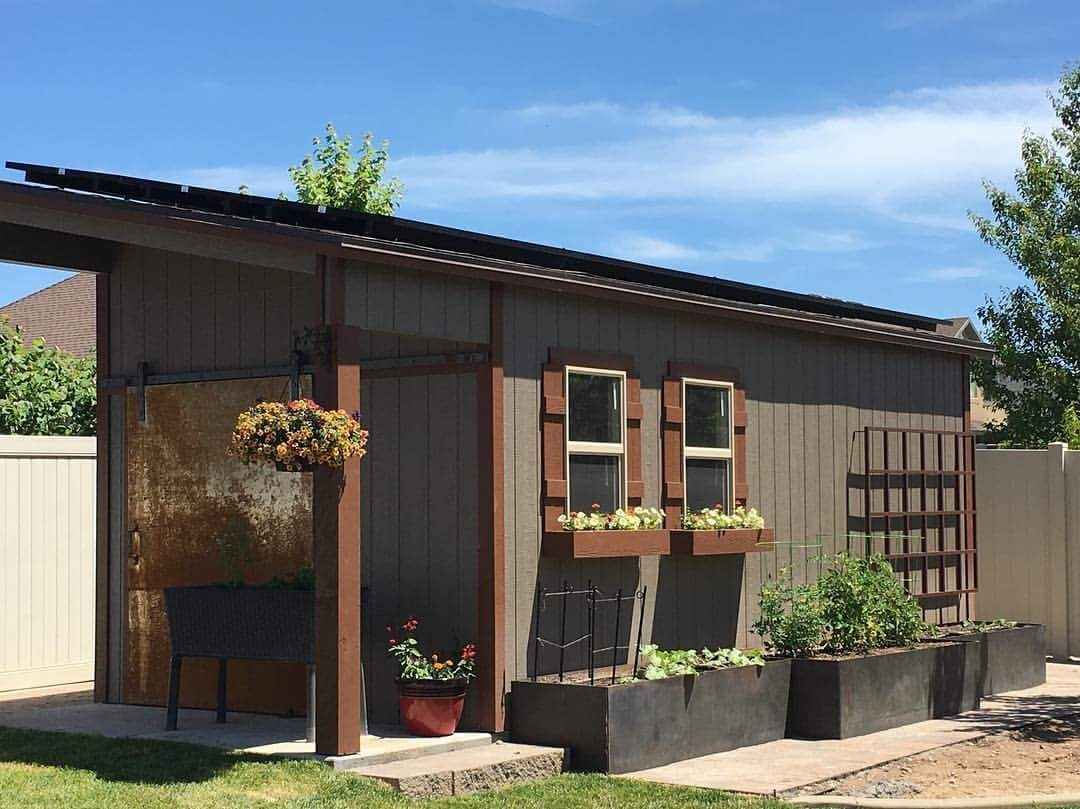Why Lean-To Shed Design Plans Are Your Smart Storage Solution
Lean to shed design plans offer the perfect blueprint for homeowners seeking efficient, space-saving storage. These versatile structures combine practical functionality with straightforward construction, making them an ideal choice for DIY builds or professional projects.
Key Benefits of Lean-To Shed Design Plans:
- Space-efficient: Built against existing structures to maximize yard space.
- Cost-effective: Requires fewer materials than gable sheds.
- Simple construction: Single-slope roof design reduces complexity.
- Versatile placement: Perfect for narrow side yards or tight spaces.
- Weather protection: Slopes water away from your home or fence.
The beauty of lean-to sheds lies in their adaptability. The single-pitch roof simplifies building, making it a popular DIY project, and creates a clean, modern aesthetic.
At Wright’s Shed Co., we’ve helped homeowners across Utah, Idaho, Nebraska, and Iowa create durable storage solutions with custom lean to shed design plans since 1997. Our on-site construction ensures every shed is built for your space with premium materials and expert craftsmanship.
Why Choose a Lean-To Shed? Unpacking the Advantages
After building custom sheds for nearly three decades across Utah, Idaho, Iowa, and Nebraska, I can confirm that lean to shed design plans are consistently one of our most popular requests. They have a unique ability to transform unused spaces into functional storage while blending seamlessly with your property.
The magic is in the single-sloped roof design. This feature allows the shed to nestle against a house, garage, or fence, creating a natural partnership. The sloped roof effectively channels water and snow away from the main building, providing excellent weather protection for both the shed and your home’s foundation.
Lean-to sheds are also incredibly versatile. I’ve seen them become potting sheds, workshops, and cozy she-sheds. Their placement against an existing structure adds a sense of security that freestanding sheds can lack. For more ideas, see our guide on Shed Styles: Exploring Unique, Versatile Options.
The Smart, Space-Saving Design
Lean-to sheds are the ultimate space-savers. They use narrow side yards and forgotten corners instead of taking up prime lawn space. This adjacent placement is brilliant for smaller lots or for homeowners who want to preserve open areas. I recall a family in Boise whose custom lean-to transformed an awkward 15-foot strip beside their garage into a functional workshop, perfectly integrating with the existing structure. This approach creates “borrowed space,” expanding storage without sacrificing your yard.
Simplicity and Cost-Effectiveness
The single-slope roof construction is practical and simple. Unlike complex gable roofs, lean-to sheds use straightforward rafter construction. This simplicity benefits both DIY builders and professionals.
From our experience, lean-to sheds require fewer materials than gable sheds, often 20-30% less. The streamlined design also means a faster build time, which helps keep labor costs down. This cost-effectiveness makes them an attractive option for homeowners who want quality storage without breaking the budget.
Key Considerations for Your Lean-To Shed Design Plans
Getting your lean to shed design plans right from the start saves time and money. After building thousands of sheds across Utah, Idaho, Iowa, and Nebraska since 1997, we know that thoughtful planning is the key to success. You’ll need to consider your shed’s purpose, size, materials, foundation, and local regulations. For more tips, see our guide on Choosing the Perfect Design for Your Backyard.
Choosing the Right Size and Dimensions
The golden rule of shed sizing? Always go a little bigger than you think you need. Many customers wish they’d added a few more feet to their original plans!
- 8×8 sheds are great for basic tools and seasonal items.
- 10×12 sheds can fit a riding mower, bikes, and hand tools.
- 12×16 sheds or larger provide ample room for a workshop.
Before finalizing plans, check your local size restrictions. Many areas allow sheds under 200 square feet without a permit, but rules vary. It’s also wise to check with your homeowners association for any restrictions on placement or appearance. When we build your Custom Lean-To Sheds: Stylish and Functional, we help you steer these requirements.
Selecting Durable Materials for a Lasting Build
Cutting corners on materials can lead to costly repairs. Your choices determine your shed’s longevity.
- Foundation: Choose between a gravel pad for excellent drainage or a concrete slab for maximum stability.
- Framing: Pressure-treated lumber (like 2x4s) is essential to resist rot and insects, a must in the climates of the Mountain West and Midwest.
- Siding & Roofing: Durable siding and architectural shingles offer superior weather resistance and a great look.
- Hardware: Don’t overlook quality fasteners and hardware to ensure structural integrity.
At Wright’s Shed Co., we use upgraded materials as standard. Our premium components and industry-leading warranties reflect our confidence in building a shed that lasts.
Finding the Perfect Spot: Location and Foundation
The right location is crucial. Consider access, drainage, and aesthetics.
Site preparation must ensure proper drainage away from the shed and your home to avoid swampy conditions. Accessibility is also key; you’ll need a clear path for moving equipment in and out. Finally, be aware of property line setbacks and any HOA rules on placement.
While Wright’s Shed Co. doesn’t build foundations, we provide expert advice on the best options for your site. Our on-site construction process ensures your shed is built perfectly for its intended location.
From Blueprint to Build: A DIY Overview
Building your own shed from lean to shed design plans can be a satisfying project. This overview covers the essential tools and steps involved in a DIY build.
Essential Tools for the Job
Having the right tools makes the job safer and more enjoyable. Here’s a basic list:
- Hand Tools: Hammer, tape measure, spirit level, utility knife, shovel, and staining brush.
- Power Tools: A reliable circular saw is essential. A drill driver and impact driver will also be invaluable.
- Safety Equipment: Always use safety goggles, ear defenders, and work gloves.
- Hardware: You’ll need wood screws, galvanized nails, caulk, hinges, and bolts.
The Construction Process: A Step-by-Step Summary
Building a lean-to shed follows a logical progression. While every project is unique, the basic steps in most lean to shed design plans are consistent.
- Site Preparation and Foundation: Clear and level the area, ensuring proper drainage. Build your foundation, whether it’s a gravel pad, concrete slab, or treated lumber skids.
- Floor Framing and Decking: Assemble the floor frame with pressure-treated lumber (e.g., 2x6s) and cover it with plywood decking.
- Wall Assembly: Frame the walls using 2×4 studs. The lean-to design requires one wall to be taller than the other to create the roof slope.
- Rafter Installation: Cut and install the roof rafters (e.g., 2x6s), ensuring they sit securely on the wall plates.
- Siding and Roofing: Attach your siding and install the roofing system, which includes sheathing, underlayment, and shingles or metal.
- Door and Window Installation: Add the final touches by installing and sealing doors and windows.
Each step involves many details. For more in-depth guidance, see our How to Build a Lean-To Shed resource.
Of course, our on-site construction process at Wright’s Shed Co. handles all these steps with professional expertise, saving you the time and hassle. We’ve refined our process since 1997 to ensure every shed meets our exacting standards.
Customizing Your Shed for Maximum Utility
A lean-to shed can be more than just storage; it can be a functional extension of your home. With the right features, you can transform your lean to shed design plans into a space that’s integral to your daily life.
Popular Add-Ons and Features for Your Lean-To Shed Design Plans
Thoughtful additions can transform a basic shed into something special. Here are some popular choices:
- Windows and Skylights: Flood the space with natural light, making it more pleasant and saving on electricity.
- Access Ramps: Essential for moving wheeled equipment like lawnmowers and wheelbarrows.
- Built-in Shelving and Workbenches: Maximize every square inch for organization and create a functional workspace.
- Vents: Crucial for air circulation to prevent moisture buildup, especially in a workshop.
- Custom Doors: Double doors provide wider access, while different placements can suit your property’s layout. For more ideas, see our guide on Lean-To Shed Layouts for Maximum Storage.
Beyond Storage: Creative Uses for Your Lean-To Shed
The versatility of lean to shed design plans allows for many creative uses.
- Home Office or Studio: An insulated, wired lean-to can be a quiet, dedicated workspace just steps from your back door.
- Garden Potting Shed: Create a command central for gardening with a workbench, shelving, and windows for seedlings.
- Workshop or Hobby Space: A dedicated area for woodworking, crafts, or tinkering where you can leave projects set up.
- Pool House: A convenient spot for storing pool supplies and for changing.
- She-Shed or Man-Cave: A personal retreat for reading, yoga, or hobbies.
At Wright’s Shed Co., we build every custom lean-to with the quality to support your creative vision. Our on-site construction process ensures your shed is perfectly custom to your needs.
Frequently Asked Questions about Lean To Shed Design Plans
Over our decades of building custom sheds across Utah, Idaho, Iowa, and Nebraska, we’ve heard just about every question imaginable about lean to shed design plans. Here are the most common ones.
How much does it cost to build a lean-to shed?
The cost of a lean-to shed depends on size, materials, and whether you build it yourself or hire professionals.
For a DIY project, material costs can vary widely based on size and quality. Remember to also factor in the cost of tools, your time, and the potential for mistakes.
Professional construction offers compelling value. Our base models start at $2,327 and go up to $10,048, with many sizes in between.
What affects price
- Size and door/window layout
- Siding and roofing selections
- Add-ons like shelves, lofts, ramps, and trim
- Site prep and access
With Wright’s Shed Co., you get expertise, efficiency, and peace of mind. Our on-site construction uses premium materials and is backed by industry-leading warranties. We are happy to provide a detailed quote based on your specific needs.
What is the best roof pitch for a lean-to shed?
The roof pitch is critical for proper drainage. Based on our experience in snow-heavy areas like Utah and Idaho, we recommend a roof pitch of 2:12 or 3:12. This means the roof rises 2 or 3 inches for every 12 inches of horizontal run.
This pitch is essential for shedding water and snow, preventing issues like standing water or structural stress from heavy snow loads. A 3:12 pitch provides excellent drainage while maintaining good interior headroom. Our design process helps you find the right balance for your climate and intended use.
Do I need a permit to build a lean-to shed?
The answer is almost always “it depends.” Permit requirements vary dramatically by municipality. Many areas allow sheds under a certain size (e.g., 200 square feet) without a permit, but this is not universal.
You also need to consider other regulations like property line setbacks, height restrictions, and rules from your homeowners association (HOA).
Our advice is to always check with your local building department and HOA first. A quick phone call can save you significant headaches. While we can offer guidance based on our experience in your area, the final authority is always your local officials.
Why Professional Lean To Shed Design Plans and On-Site Construction Are Your Best Bet
While a DIY project using lean to shed design plans can be rewarding, I’ve seen many homeowners find the reality of construction challenges and weather delays. Partnering with local experts like Wright’s Shed Co. ensures a high-quality, long-lasting result without the headaches or costly mistakes of a first-time build.
Our on-site construction process is what truly sets us apart. We don’t ship a pre-built shed; our skilled craftsmen build your lean-to from the ground up on your property. This allows us to ensure perfect leveling and create a structure that integrates seamlessly with your space.
We use superior materials as our standard, not as upgrades. Quality components like premium lumber, durable siding, and robust hardware save you money in the long run by preventing premature wear and tear.
Our industry-leading warranties reflect our confidence in our craftsmanship. As local experts in Utah, Idaho, Iowa, and Nebraska, we understand the climate and build sheds designed to withstand everything from heavy snow to intense summer heat. While we don’t build foundations, we offer expert advice on the best options for your site.
When you’re ready for a professional solution, I invite you to explore our custom lean-to shed options and pricing. Let us create the perfect storage solution for your needs.





